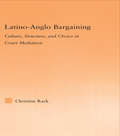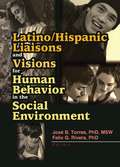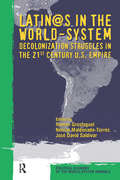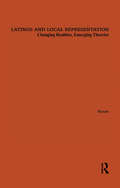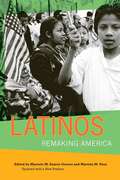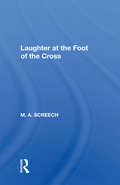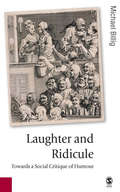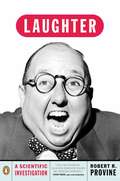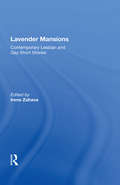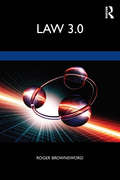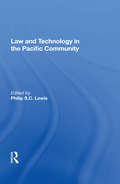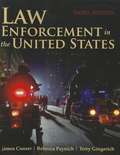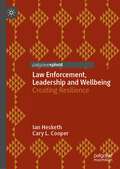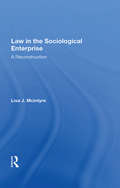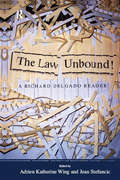- Table View
- List View
Latino-Anglo Bargaining: Culture, Structure and Choice in Court Mediation (Latino Communities: Emerging Voices - Political, Social, Cultural and Legal Issues)
by Christine RackThis book shows the mechanisms by which cultural differences reinforce structural privilege and disadvantage in the informal process of mediated negotiation. Are all people equally likely to pursue their own material self-interest in the negotiation process used in small claims mediation? Did Latinos and Anglos bargain more generously with members of their own group? The central questions, derived from theories of ethnic and gender differences, concerned how, and to what degree; culture, structure, and individual choice operated to alter the goals, bargaining process and outcomes, expressed motivations and outcome evaluations for outsider groups. This book demonstrates how there are real cultural differences in the way that Latinos and Anglos pursue monetary justice that defy dominant assumptions that all culture groups are equally likely to maximize their own outcomes at the expense of others.
Latino/Hispanic Liaisons and Visions for Human Behavior in the Social Environment
by Felix G RiveraAdd to your knowledge of Latino/Hispanic diversity, attitudes, behaviors, and experiences to provide more effective services!Latino-Hispanic Liaisons and Visions for Human Behavior in the Social Environment dispels pervasive historical and contemporary misconceptions and inaccuracies and highlights the diversity of Latino/Hispanic experiences to help you provide more effective services to those clients. As editors Torres and Rivera point out, “Literature on Latinos/Hispanics reflects a dysfunctional and myopic cultural view in which they are often depicted in stereotypic characteristics and as a homogenous population.”In Latino-Hispanic Liaisons and Visions for Human Behavior in the Social Environment, you&’ll find chapters examining: the social ecology of Mexican-American child development caregiver well-being among Cuban and Puerto Rican mothers of mentally retarded adults the adjustment process among Cuban refugee families one Southwestern community’s efforts to create a multiethnic neighborhood coalition against substance abuse a study of changes related to migration, family, and work in Caribbean women’s lives and much more!
Latino/as in the World-system: Decolonization Struggles in the 21st Century U.S. Empire (Political Economy of the World-System Annuals)
by Nelson Maldonado-Torres Ramon Grosfoguel Jose David SaldivarContributors Immanuel Wallerstein, Enrique Dussel, Walter Mignolo, Agustin Lao, Lewis Gordon, James V. Fenelon, Roberto Hernandez, James Cohen, Santiago Slabosky, Susanne Jonas, and Thomas Reifer. By the mid-twenty-first century, white Euro-Americans will be a demographic minority in the United States and Latino/as will be the largest minority (25 percent). These changes bring about important challenges at the heart of the contemporary debates about political transformations in the United States and around the world. Latino/as are multiracial (Afro-latinos, Indo-latinos, Asian-latinos, and Euro-latinos), multi-ethnic, multireligious (Jewish, Catholic, Protestant, Muslim, indigenous, and African spiritualities), and of varied legal status (immigrants, citizens, and illegal migrants). This collection addresses for the first time the potential of these diverse Latino/a spiritualities, origins, and statuses against the landscape of decolonization of the U.S. economic and cultural empire in the twenty-first century. Some authors explore the impact of Indo-latinos and Afro-latinos in the United States and others discuss the conflicting interpretations and political conflicts arising from the "Latinization" of the United States.
Latinos and Local Representation: Changing Realities, Emerging Theories (Latino Communities: Emerging Voices - Political, Social, Cultural and Legal Issues)
by Florence AdamsThis study examines trends in Voting Rights Act enforcement and the results for Latino representation. The focus is on local governments of the West and Southwest: some of the communities examined, Latino population is increasing rapidly, often to majority status; and in others, white suburban development is outnumbering, sometimes displacing Latinos. In both situations, district lines can decide the future political power of Latinos and non-Latinos alike. The local distributing process, which has never been studied in depth, is shown to be reshaping the political and racial landscape. This study looks behind legal and theoretical formulations to the realities of local districtings and redistrictings. The author, who participated as principal cartographer in the jurisdictions that are discussed, explores the decisions involved in reflecting rapid population change, the dangers of drawing districts without attention to the vitality of local organization, the problems of displacing incumbents, the unforeseen consequences of district designs, the difficulty of predicting outcomes, and the many ethical dilemmas of line-drawing. In several jurisdictions, Latinos are nearing majority status: Do concepts such as the majority-minority district and single-member districts remain relevant there? Are concerns for African American representation in southern states, which have guided so much voting rights enforcement, truly relevant to western and southwestern politics? What are the actual results--in terms of the numbers of Latinos elected--of voting rights litigation? Such questions are discussed against the backdrop of actual line-drawings, but in such a way as to contribute to voting rights theory.
Latinos in Ethnic Enclaves: Immigrant Workers and the Competition for Jobs (Latino Communities: Emerging Voices - Political, Social, Cultural and Legal Issues)
by Stephanie BohonThis work explores the competition for jobs between different Latin American immigrant groups in the U.S. economy. Bohon's research looks at occupational status attainment among Latino groups in Miami and three other U.S. cities with flourishing Latino enclaves.
Latinos in the Legislative Process
by Stella M. RouseIn one of the only accounts of Latino legislative behavior, Stella M. Rouse examines how well the growing Latino population translates their increased presence into legislative influence. Latinos in the Legislative Process explores Latino representation by considering the role of ethnicity throughout the legislative process - from bill sponsorship, to committee deliberations, to floor votes - in seven state legislatures. Rouse first identifies issues that are priorities for Latinos and tells us whether a Latino political agenda exists. She then provides a theoretical framework for ethnicity in legislative behavior and outcomes. Rouse demonstrates that ethnicity is a complex dynamic that plays a variable role in the legislative process. Thus, Latino representation cannot be viewed monolithically.
Latinos: Remaking America
by Marcelo Suarez-Orozco Mariela PaezProbing the themes of transnationalism, race, gender, and class, this pathbreaking volume by a group of eminent scholars provides the most incisive and comprehensive look to date at what every citizen needs to know about the Latino experience in the United States
Latinx Queer Psychology: Contributions to the Study of LGBTIQ+, Sexual and Gender Diversity Issues
by Reynel Alexander Chaparro Marco Aurélio Máximo PradoThis book brings together studies that contribute to the emergence of a latinx queer psychology. LGBTQ+ studies have gradually included the perspective of sexual and gender diversity, but they have been predominantly elaborated from North American and European perspectives. This book focuses on different understandings and practices developed by Latin American researchers that contribute to a broader application of psychological knowledge in LGBTQ+ studies, as well as sexual and gender diversity issues, but goes beyond the region by also incorporating chapters written by European and North American authors influenced by latinx perspectives.Latin American psychology has developed original approaches to LGBTQ+ studies based on a new theoretical critique to the mainstream psychological theories that has given rise to a new queer psychology. The chapters in this book showcase both theoretical contributions and empirical researches in this emerging field from six Latin American countries – Argentina, Brazil, Chile, Colombia, Costa Rica and Uruguay – as well as from Spain, the United States and Puerto Rico. Latinx Queer Psychology: Contributions to the Study of LGBTIQ+, Sexual and Gender Diversity Issues aims to contribute to the decolonization of psychological knowledge and practices addressing sexual and gender diversity issues, and to serve as a useful resource for social, community, clinical and educational psychologists working with research and practice involving LGBTIQ+ populations, as well as to social scientists in general interested in queer and gender studies.
Latter-Day Pamphlets
by Thomas CarlyleThe following Occasional Discourse, delivered by we know not whom, and of date seemingly above a year back, may perhaps be welcome to here and there a speculative reader. It comes to us, - no speaker named, no time or place assigned, no commentary of any sort given, - in the handwriting of the so-called "Doctor," properly "Absconded Reporter," Dr. Phelim M'Quirk, whose singular powers of reporting, and also whose debts, extravagancies and sorrowful insidious finance-operations, now winded-up by a sudden disappearance, to the grief of many poor tradespeople, are making too much noise in the police-offices at present! Of M'Quirk's composition we by no means suppose it to be; but from M'Quirk, as the last traceable source, it comes to us; - offered, in fact, by his respectable unfortunate landlady, desirous to make-up part of her losses in this way. To absconded reporters who bilk their lodgings, we have of course no account to give: but if the Speaker be of any eminence or substantiality, and feel himself aggrieved by the transaction, let him understand that such, and such only, is our connexion with him or his affairs. As the Colonial and Negro Question is still alive, and likely to grow livelier for some time, we have accepted the Article, at a cheap market-rate; and give it publicity, without in the least committing ourselves to the strange doctrines and notions shadowed-forth in it. Doctrines and notions which, we rather suspect, are pretty much in a "minority of one," in the present era of the world! Here, sure enough, are peculiar views of the Bights of Negroes; involving, it is probable, peculiar ditto of innumerable other rights, duties, expectations, wrongs and disappointments, much argued of, by logic and by grape-shot, in these emancipated epochs of the human mind! - Silence now, however; and let the Speaker himself enter. My Philanthropic Friends, - It is my painful duty to address some words to you, this evening, on the Rights of Negroes. About the Publisher Forgotten Books publishes hundreds of thousands of rare and classic books. Find more at www.forgottenbooks.com This book is a reproduction of an important historical work. Forgotten Books uses state-of-the-art technology to digitally reconstruct the work, preserving the original format whilst repairing imperfections present in the aged copy. In rare cases, an imperfection in the original, such as a blemish or missing page, may be replicated in our edition. We do, however, repair the vast majority of imperfections successfully; any imperfections that remain are intentionally left to preserve the state of such historical works."
Laughter At The Foot Of The Cross
by M.a. Screech"Christian laughter is a maze: you could easily get snarled up within it." So says Michael A. Screech in his note to readers preceding this collection of fifty-three elegant and pithy essays. As Screech reveals, the question of whether laughter is acceptable to the god of the Old and New Testaments is a dangerous one. But we are fortunate in our gu
Laughter Out of Place: Race, Class, Violence, and Sexuality in a Rio Shantytown
by Donna M. GoldsteinLaughter Out of Place provides an intimate portrait of everyday life among women living in the shantytowns of Rio de Janeiro in the 1990s.
Laughter and Ridicule: Towards a Social Critique of Humour (Published in association with Theory, Culture & Society)
by Michael Billig`From Thomas Hobbes' fear of the power of laughter to the compulsory, packaged "fun" of the contemporary mass media, Billig takes the reader on a stimulating tour of the strange world of humour. Both a significant work of scholarship and a novel contribution to the understanding of the humourous, this is a seriously engaging book' - David Inglis, University of Aberdeen This delightful book tackles the prevailing assumption that laughter and humour are inherently good. In developing a critique of humour the author proposes a social theory that places humour - in the form of ridicule - as central to social life. Billig argues that all cultures use ridicule as a disciplinary means to uphold norms of conduct and conventions of meaning. Historically, theories of humour reflect wider visions of politics, morality and aesthetics. For example, Bergson argued that humour contains an element of cruelty while Freud suggested that we deceive ourselves about the true nature of our laughter. Billig discusses these and other theories, while using the topic of humour to throw light on the perennial social problems of regulation, control and emancipation.
Laughter: A Scientific Investigation
by Robert R. ProvineWhy do we laugh? Laughter has surprisingly little to do with jokes and funny stories. It is an ancient, unconsciously controlled vocal relic that co-exists with our relatively modern speech - a social, psychological and biological act which predates humour and is sharedwith our primate cousins, the great apes. In this fascinating book Robert Provine uses laughter as a powerful probe into human social relationships, revealing that tickling is a form of tactilecommunication, not a reflex; that women laugh more at men than vice-versa; that speakers laugh more than their audiences; and that laughter is mostly about relationships, not jokes. Using the latest evidence, Provine describes laughter using sonic analysis and opera scores, evaluates whether you can 'laugh you way to health', considers what laughter shows about neuropathology, and suggests how to change environments to increase laughter. The first book to establish laughter as a topic of scientific worth, Laughter also includes such esoterica as the history of holy laughter, laughing gas, canned laughter, and a description of the Tanganyikan laughter epidemic that immobilized an entire school district in 1962.
Lauter gute Leute: Das Ehrenamt in den Sozialen Diensten zwischen Legitimationsnutzen und Transaktionskostenregulierung
by Stefanie Lünsmann-SchmidtWarum binden professionelle Organisationen ehrenamtliche Laien in ihre Organisationsstruktur ein? Keineswegs, weil sie damit Kosten sparen können. Dieses Buch zeigt, welchen legitimativen Nutzen Soziale Dienste damit verbinden. Es zeigt auch, mit welchen Strategien sie die Kosten regulieren, die durch das Ehrenamt entstehen. In dieser Arbeit werden erstmals die Kosten-Nutzen-Aspekte des Ehrenamtes theoretisch fundiert und empirisch belegt. Die Erkenntnisse lassen sich auf alle weiteren Non-Profit-Organisationen übertragen
Lavender Mansions: 40 Contemporary Lesbian And Gay Short Stories
by Irene ZahavaGeorge Stambolian, Terri de la Peña, Audre Lorde, Paul Monette, Edmund White, and Jaime Manrique are just six of the writers represented in this collection of forty contemporary lesbian and gay short stories. Gathered together for the first time in one volume are writings by both lesbians and gay men who represent a multiplicity of ethnic and racial backgrounds. Irene Zahava has compiled a unique and necessary collection, selecting stories for their artistic power and for their treatment of topics that are significant in lesbian and gay life and politics today. An alternative thematic table of contents allows the reader to understand lesbian and gay life according to its most culturally and politically significant themes: childhood/growing up; coming out/finding community; families; oppression/resistance; bisexuality; relationships/friendships; AIDS; and aging/dying.
Law 3.0: Rules, Regulation, and Technology
by Roger BrownswordPutting technology front and centre in our thinking about law, this book introduces Law 3.0: the future of the legal landscape. Technology not only disrupts the traditional idea of what it is ‘to think like a lawyer,’ as per Law 1.0; it presents major challenges to regulators who are reasoning in a Law 2.0 mode. As this book demonstrates, the latest developments in technology offer regulators the possibility of employing a technical fix rather than just relying on rules – thus, we are introducing Law 3.0. Law 3.0 represents, so to speak, the state we are in and the conversation that we now need to have, and this book identifies some of the key points for discussion in that conversation. Thinking like a lawyer might continue to be associated with Law 1.0, but from 2020 onward, Law 3.0 is the conversation that we all need to join. And, as this book argues, law and the evolution of legal reasoning cannot be adequately understood unless we grasp the significance of technology in shaping both legal doctrine and our regulatory thinking. This is a book for those studying, or about to study, law – as well as others with interests in the legal, political, and social impact of technology.
Law And Technology In The Pacific Community
by Philip S.C. LewisMost would agree that business and trade are now carried out in an international environment, but it is much less widely recognized that the practice of the law of business and technology is also becoming internationalized. Indeed, in many ways we seem to be rapidly moving toward a world legal order that may parallel the world economic order. In th
Law Enforcement and Public Health: Partners for Community Safety and Wellbeing
by Denise Martin Isabelle Bartkowiak-Théron James Clover Richard F. Southby Nick CroftsThe expanding remit of policing as a fundamental part of the public health continuum is increasingly acknowledged on the international scene. Similarly the growing role of health professionals as brokers of public safety means that the need for scholarly resources for developing knowledge and broadening theoretical positioning and questioning is becoming urgent and crucial. The fields of law enforcement and public health are beginning to understand the inextricable links between public safety and public health and the need to shift policies and practices towards more integrated practices. This book comes as a first, an utterly timely scholarly collection that brings together the views of multidisciplinary commentators on a wide range of issues and disciplines within the law enforcement and public health (LEPH) arena. The book addresses the more conceptual aspects of the relationship as well as more applied fields of collaboration, and the authors describe and analyze a range of service delivery examples taken from real-life instances of partnerships in action. Among the topics covered:Defund, Dismantle or Define Law Enforcement, Public Health, and Vulnerability Law Enforcement and Mental Health: The Missing Middle The Challenges of Sustaining Partnerships and the Diversification of Cultures Using Public Health Concepts and Metrics to Guide Policing Strategy and Practice Policing PandemicsLaw Enforcement and Public Health: Partners for Community Safety and Wellbeing is essential reading for a wide array of professions and areas of expertise in the intersectoral field of LEPH. It is an indispensable resource for public health and law enforcement specialists (practitioners, educators, scholars, and researchers) and training programs across the world, as well as individuals interested in developing their knowledge and capacity to respond to complex LEPH issues in the field, including public prosecutors, coroners, and the judiciary. The text also can be used for undergraduate and postgraduate university policing, criminology, sociology, psychology, social work, public health, and medicine programs.
Law Enforcement in the United States
by James A. Conser Rebecca Paynich Terry E. GingerichThis book is an ideal introduction to law enforcement and goes beyond discussions of local policing to examine how forces like technology, privatization, and the threat of terrorism are affecting law enforcement on local, state, and national levels. Readers will learn how these diverse and unpredictable forces are shaping the future of law enforcement in the United States, and will come away with the ability to think critically about law enforcement issues. New Material added to the revised and updated Third Edition:-"Stay Current" boxes throughout the text offer references and key search terms for further internet research-Updated figures, tables, charts and other statistical and descriptive information-A New chapter on socialization, advancement, and professionalism, including ethics and misconduct-A New chapter with emphasis on law enforcement's role in national security, homeland security, and protecting private assets-A separate chapter on "Policing Strategies, Tactics, and Daily Operations"-An expanded and updated chapter on management issues-Updated and expanded appendices
Law Enforcement, Leadership and Wellbeing: Creating Resilience
by Cary L. Cooper Ian HeskethThis book provides practical guidance on establishing wellbeing services and interventions within policing for all of those working in law enforcement, particularly leaders and HR professionals. It also offers insight, provokes thought, and gives guidance on how to navigate and get the most from working life as a police officer or member of police support staff. With a focus on the modern working environment, the book covers the key concepts, history, and practical advice necessary for all those interested in this fascinating field of law enforcement. As workplaces become ever more complex and ambiguous, and the world of work ever more dynamic, understanding how organizations behave and how those in the workplace are likely to respond is key to bringing meaning and purpose to work, the cornerstone of effective policing. The book details how to effectively measure workplace wellbeing in policing and how to interpret and use findings to make improvements and craft interventions. It is a key text for exploring law enforcement, leadership, and wellbeing within policing for all those involved with law enforcement, as well as HR professionals, occupational health professionals, and critically, those with police line management responsibilities.
Law In The Sociological Enterprise: A Reconstruction
by Lisa J. McIntyreFew would dispute the notion that law has a tremendous impact on modern life. But social scientists who study the dynamics of family, work, and other important social institutions often ignore the pervasive influence of law. This introduction to the legal world and the sociology of law shows how social scientists can better account for the influences of legal issues in a wide range of social settings. Incorporating historical and cross-cultural research into her book, Lisa J. McIntyre explains the general effects of law on interpersonal relations, the concept of the civil contract, and the relationship between law and social norms. She discusses why some societies and domains within societies have more law than others and shows that, contrary to popular wisdom, law is not only a reflection of social values but also fundamental to the formation of those values.
Law Unbound!: A Richard Delgado Reader
by Richard Delgado Jean Stefancic Adrien Katherine WingThis book offers the best and most influential writings of Richard Delgado, one of the founding figures of the critical race theory movement and one of the earliest scholars to address the harms of hate speech. With excerpts from his classic law review articles, conversations with his famous alter ego Rodrigo Crenshaw, and comments on the vicissitudes of academic life, this book spans topics such as hate speech, affirmative action, the war on terror, the endangered status of black men, and the place of Latino/as in the civil rights equation.
Law Without Lawyers: A Comparative View Of Law In The United States And China
by Victor H. LiThe U.S. has 400,000 lawyers in a society of 200 million people. China, a country with four times that population, has a mere 3,500 lawyers. How do the Chinese achieve law without lawyers? Victor Li, one of the world's leading authorities on Chinese law, explores the way the Chinese and U.S. systems have historically viewed law (and still view it), and the way each system functions in everyday life to shape conduct and control deviance. In a straightforward and highly readable manner, the author examines how these highly divergent societies operate. He writes about historical forces and cultural values that are centuries old—and that are still critical influences in shaping life in modern America and China. In explaining the differences in the tradition and operation of law in these two cultures, Li gives us both an invaluable understanding of Chinese society today and his own appraisal of the strengths and weaknesses of U.S. law, lawyers, and courts.
Law and Christianity: Pope Benedict XVI’s Legal Thought
by Cartabia, Marta and Simoncini, Andrea Marta Cartabia Andrea SimonciniThroughout Pope Emeritus Benedict XVI's pontificate he spoke to a range of political, civil, academic, and other cultural authorities. These speeches reveal a striking sensitivity to the fundamental problems of law, justice, and democracy. He often presented a call for Christians to address issues of public ethics such as life, death, and family from what they have in common with other fellow citizens: reason. This book discusses the speeches in which the Pope Emeritus reflected most explicitly on this issue, along with commentary from distinguished legal scholars. It responds to Benedict's invitation to engage in public discussion on the limits of positivist reason in the domain of law from his address to the Bundestag. Although the topics of each address vary, they are joined by a series of core ideas whereby Benedict sketches, unpacks, and develops an organic and coherent way to formulate a 'public teaching' on justice and law.
Law and Cultural Studies: A Critical Rearticulation of Human Rights
by John Nguyet ErniNew and unremitting violence linked to state, inter-state, and private actors has precipitated a renewal of social movements, many of which act in concert with human rights ethos and legal conceptions. Yet, cultural studies has so far had little engagement or institutional connection with these movements. How can cultural studies as a progressive discipline think with, and make space for, rights-inflected legal and humanitarian practices? This book considers the ways in which cultural humanism and the critical approach to rights, and more broadly between culture and law, can be brought together to open a new intellectual space to allow cultural studies to better engage with the current challenges presented by social and political struggles worldwide. It lays out the central theses essential for constructing a critical view of human rights, and then advances a distinctive critical model of analysis that incorporates insights of postcolonial legal theorists and jurists from the Global South and important cultural theorists from the North, while rethinking law, rights, and social movements as something constituted by multiple legal modernities. Through case studies covering questions relating to sovereignty, citizenship, refugee displacement, human rights defenders, and gender and sexual rights, Law and Cultural Studies develops a means by which the practice of cultural studies can be reinvigorated around the legal spaces, institutions, and movements tied to human rights struggles. As such, it will appeal to scholars of cultural and media studies, critical legal studies, political theory, postcolonial studies, and human rights.
